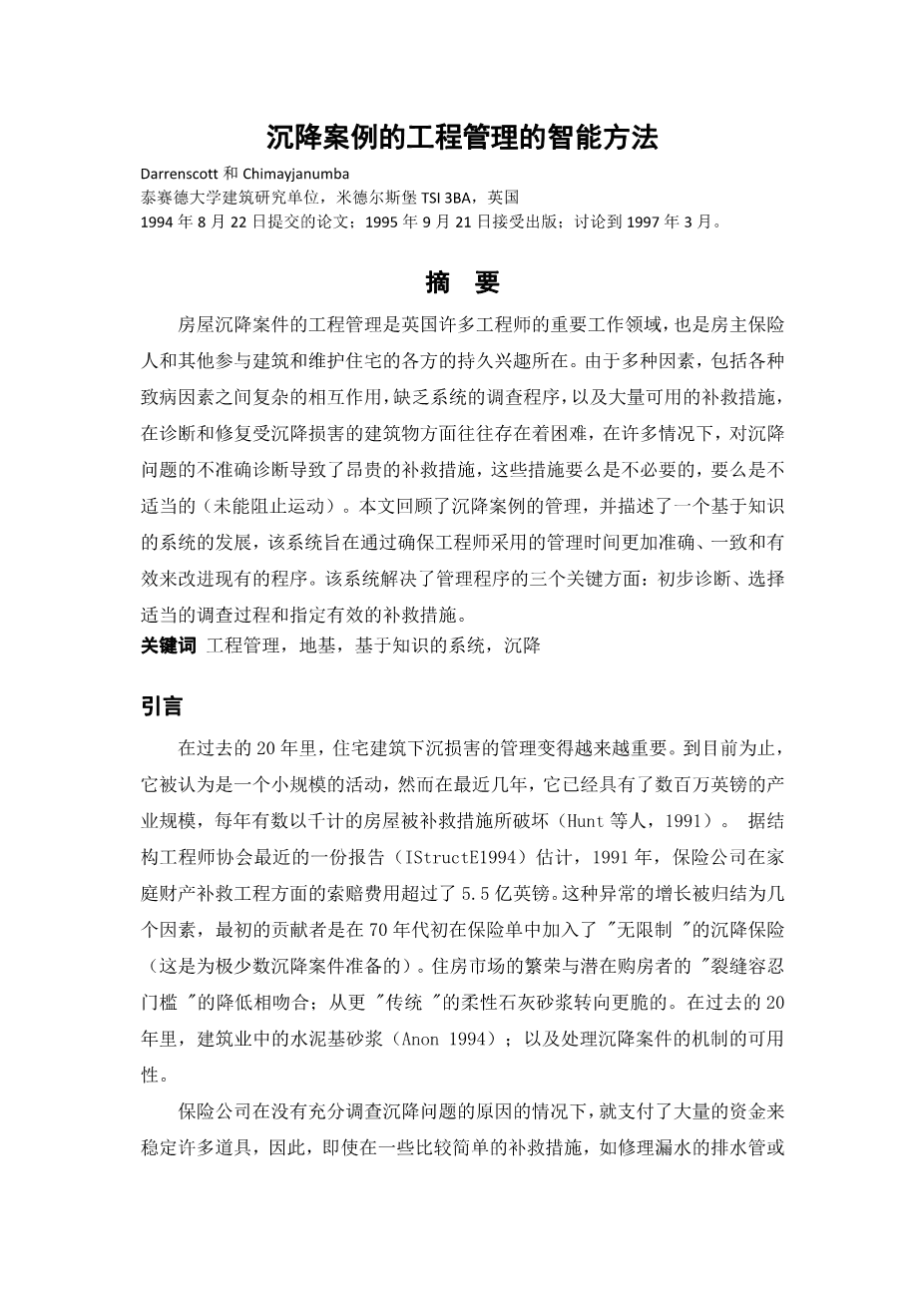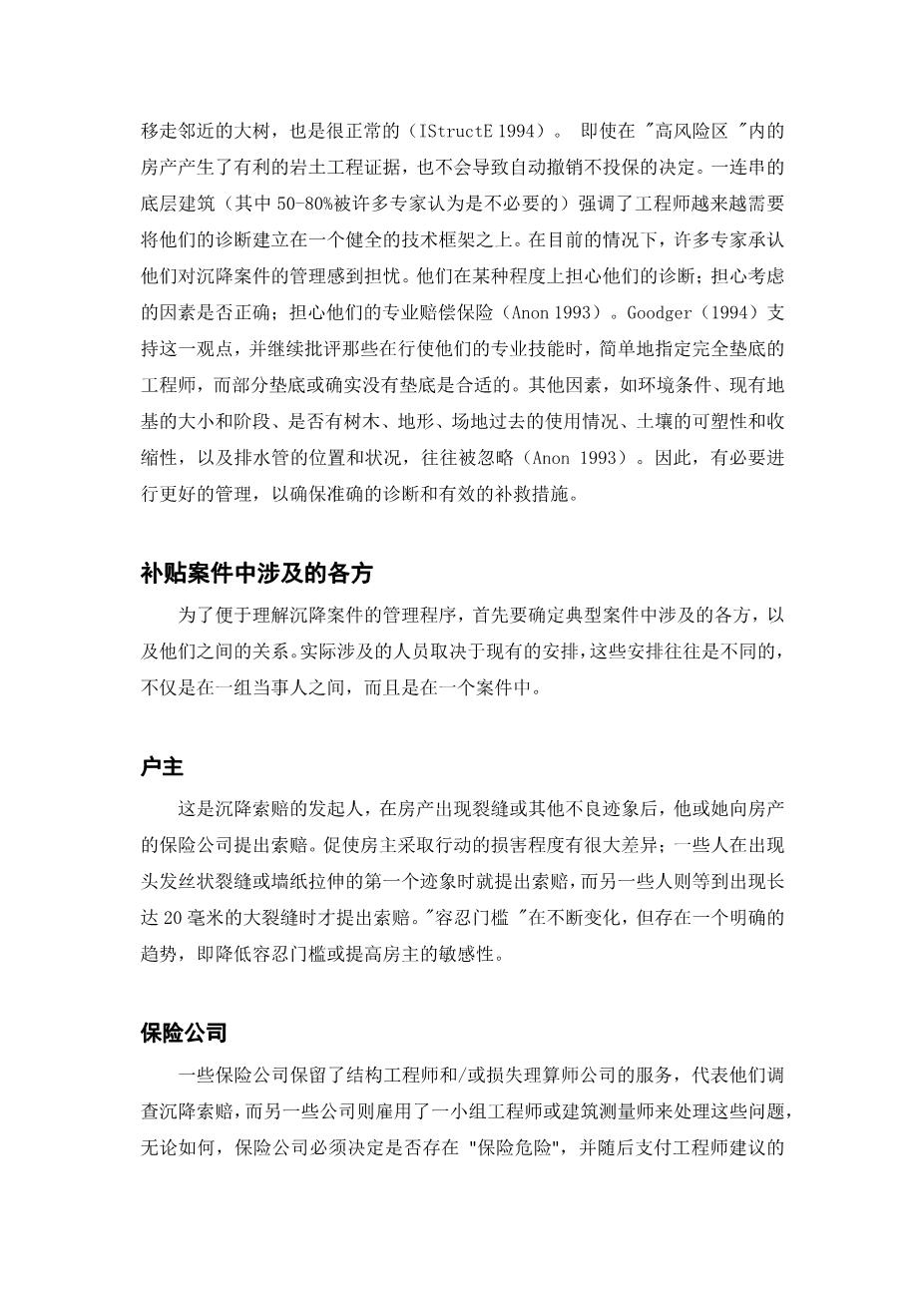An intelligent approach to the engineering management of subsidence cases
DARRENSCOTTamp;CHIMAYJANUMBA
Construction Research Unit, University of Teesside,Middles brough TSI 3BA, UK
Paper submitted 22 August 1994; accepted for publication 21 September 1995; discussion open until March 1997
Abstract
The engineering management of housing subsidence cases is an important field of work for many UK engineers,and remains of enduring interest to householders insurers and other parties involved in the construction and maintenance of resident buildings.There are often difficulties in the diagnosis and repair of buildings subject to subsidence damage due to several factors,including the complex interaction between the various causative agents, the lack of a systematic investigation procedure, and the large number of available courses of remedial action many cases, inaccurate diagnosis of the subsidence problem has resulted in expensive remedial measures which are the unnecessary or inappropriate (and fail to arrest the movement).This paper reviews the management of subsidence cases and describes the development of a knowledge-based system intended to improve existing procedures by ensuring greater accuracy.consistency and effectiveness of the management adopted by engineers. The system addresses three key aspects of the management procedure: initial diagnosis,choice of an appropriate course of investigations,and the specification of effective measures.The benefits of the knowledge based system are contained in the concluding section of the paper.
Keywords engineering management,foundations,knowledge-based systems, subsidence
INTRODUCTION
The management of subsidence damage to residential buildings has increased in importance over the last 20 years. Hitherto, it was considered a small-scale activity,In recent years.however,it has assumed the scale of a multi-mi9llion pound industry,with thousands of houses being disrupted by remedial measures each year(Huntetal1991).A recent report by the Institution of Structural Engineers(IStructE1994)estimated that the cost of claims to insurance companies in respect of remedial works to domestic properties in the year 1991 exceededpound;550m(Fig1)This exceptional rise has been attributed to several factors,the initial contributor being the inclusion of unlimitedrsquo; subsidence cover in insurance policies in the early 1970s (this was intended for very few subsidence cases)Other factors contributing to the increased number of claims include the dry periods in the 1970s and 1980s; the boomrsquo; in the housing market coinciding with a decreasing crack tolerance thresholdrsquo; of prospective home buyers; the switch from the more traditionalrsquo; flexible lime mortars to more brittle.cement based mortars in the construction industry in the last 20 years(Anon 1994);and the availability of mechanisms for dealing with subsidence cases.
Insurance companies paid out vast amounts of money to stabilize many prop ertics without adequately investigating the cause(s) of the subsidence problem Consequently,underpinning became the norm even in cases where simpler remedies such as the repair of leaking drains or the removal of large adjacent trees have been adequate(IStructE 1994)The rise in claims and the consequent huge cost to insurance companies made them reluctant to cover properties in areas known to be susceptible to subsidence damage.Even the production of favourable technical evidence in respect of a property within a high risk zone did not result in an automatic rescission of the decision not to insure.
The spate of underpinnings(50-80% of which many specialists consider unnccessary)has highlighted the growing need for engineers to base their diagnosis on a sound technical framework. Under the present dispensation, many specialists admit concerns about their management of subsidence cases. They worry about their diagnosis, to a degree; about whether factors taken into account were the right ones; and about their professional indemnity cover(Anon 1993) Goodger(1994)supports this and goes on to criticize those engineers who have summarily specified complete underpinning when,by the exercise of their professional skill, partial underpinning or indeed no underpinning would have sufliced.The primary factor commonly taken into account by professionals called in to investigate housing subsidence is the extent of damage. Other factors such as the environmental conditions, size and stage of existing foundations, presence or absence of trees, topography, past usage of the site, plasticity and shrinkage potential of the soil, and the proximity and condition of drains are often ignored(Anon 1993).There is therefore a need for better management in order to ensure accurate diagnoses and effective remedial measures.
THE PARTIESINVOLVEDINSUBSIDENCECASES
To facilitate an understanding of the subsidence case management procedure, it is useful first to identify the parties involved in a typical case, and the relationships between them.The actual people involved depends on the existing arrangements which often vary, not only from one set of parties to another but also from one case to another.However, the principal parties involved in a typical case include the householder, the insurance company,the structural engineer(or other construction professional),the loss adjuster,and the contractor.A simplified model of the relationships between these parties is shown in Fig.2.
The householder
This is the originator of a subsidence claim. Following the appearance of cracks or other distress signs on the property,he or she puts in a claim to the insurers of the property. There are wide variations in the level of damage which prompts the householder into action; some put in a claim at the first sign of a hairline crack o
剩余内容已隐藏,支付完成后下载完整资料


英语译文共 14 页,剩余内容已隐藏,支付完成后下载完整资料
资料编号:[603728],资料为PDF文档或Word文档,PDF文档可免费转换为Word
课题毕业论文、外文翻译、任务书、文献综述、开题报告、程序设计、图纸设计等资料可联系客服协助查找。


